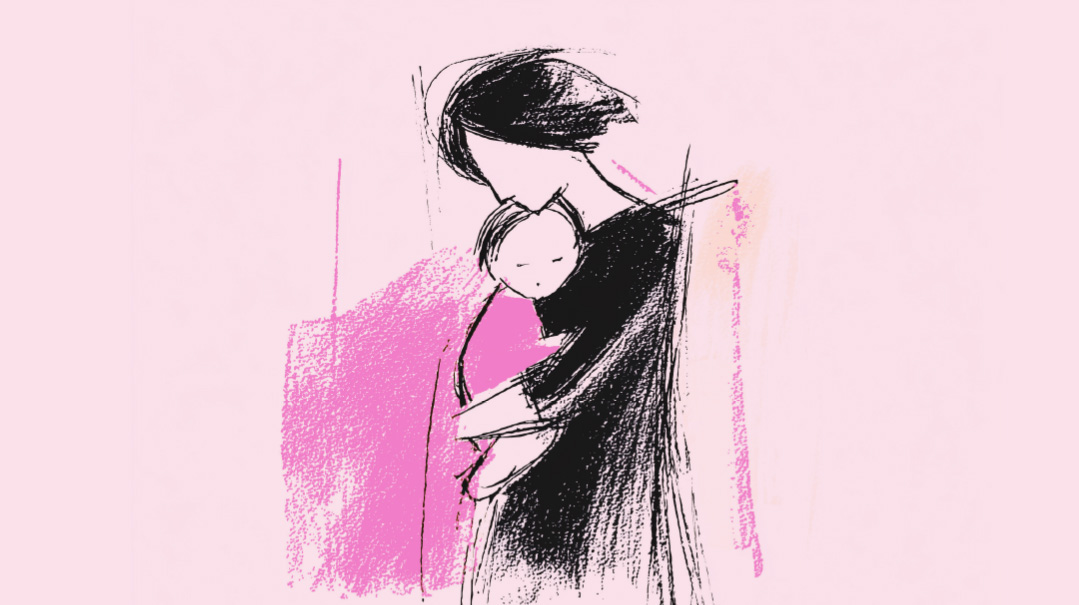Northern Lights

These women, who live in Meron year-round, wouldn’t have it any other way. Because once Rabi Shimon has summoned you, there’s no turning back

Living rooms swell with guests, mattresses overflow into bathrooms and chicken coops, quiet roads throng with people. Overnight, an idyllic village transforms into the hub of the country, bustling with crowds and cacophony… and yet these women, who live in Meron year round, wouldn’t have it any other way. Because once Rabi Shimon has summoned you, there’s no turning back
“Someone called me on Lag B’omer morning — I have no idea how she got my phone number — but she asked if she could come here to rest,” remembers Bracha Bolton, who has lived in Meron for over ten years. “Of course, I told her she could come, and I offered to pick her up from the grocery store. When I got there, I saw another woman who also asked if she could come. I was happy to help, and the two women came and rested in our bedroom.
“A few hours later, I knocked on the door — we needed the room! — only to see that one of them had rearranged the furniture and her belongings, as if she were planning on staying for a while. And she ended up staying by us for the rest of the week — and then longer and longer, until we were sure that she’d decided to stay with us permanently. After two months, she finally packed up and left.”
It’s a wild story, but it barely raises in eyebrow in Meron, where inhabitants are used to opening their homes and hearts — and bedrooms! — to the thousands upon thousands of visitors who travel to the quiet town in northern Israel. Secular Israelis in search of salvation, seminary students traversing the country, American businessmen loathe to close a big deal before seeking Rabi Shimon’s approval — all pour out their hearts near the ancient kever of the Tanna Rabi Shimon bar Yochai.
By living in Meron, says Rabbanit Aliza Peretz, she has become an emissary of Rabi Shimon. “Rabi Shimon has such incredible power that he can bring thousands of people to him and unite them under one roof. Here there’s no Vizhnitz or Ger or Breslov, there’s no Moroccan or Litvish or Yemenite. Everyone sits on the same bench with no differences between them. And that’s what’s so heartwarming with Rabi Shimon. Because Rabi Shimon pulls everyone here and accepts everyone.”
It was that pull that brought Rabbanit Peretz to Meron, 28 years ago — for just one year. “My husband told me, ‘Stay here for a year and then tell me if you want to leave,’” Rabbanit Peretz remembers. “The year ended, and there were no more questions. I said to my husband, ‘We’re not going back. A bulldozer couldn’t move me.’ Someone who loves Rabi Shimon can’t leave.”
It’s that love for Rabi Shimon that transforms the village each year, as thousands of Jews descend upon Meron for Rabi Shimon’s hilulah on Lag B’omer — a night of spirited dancing, lusty singing, and fervent prayer.
It’s a night that many claim brought them salvation, a night many cite as pivotal to their entire year’s spiritual growth. And like all good things, it doesn’t come easy.
Preparing for the Big Night
“I begin preparing for Lag B’omer in Teves,” Bracha says. “We have a giant chicken coop in our yard that came with the house. Starting in Teves, we fix it up so we can use it to house the dozens of guests we have on Lag B’omer. We also erect tents in our yard, and everyone sits outside, learning, singing, and having farbrengens.
“One year, at 5 a.m., when everyone had finally gone to sleep, it started pouring. Our guests got up and helped my husband schlep all the mattresses and blankets into the house, but everything was already soaked. From then on, we learned our lesson, and prepared another sheltered area.”
The Zelikowitzes, another Meron family, also have guesthouses they rent out. “They’re fully occupied all year long, baruch Hashem, but when it comes to Lag B’omer, they’re usually reserved several months, or even a year, in advance,” says Miri Zelikowitz. “Sometimes one person will rent all the apartments, and then he sublets them to other people.”
The Zelikowitzes also have a large shed that they use to store medical equipment they lend out. On Lag B’omer, they clear out the shed and fill it with pillows, blankets, and mattresses. Miri says that dozens of friends and relatives, for whom she prepares meals, sleep in the shed.
Called by Rabi Shimon
“The most incredible thing to see is that there are people who are just called by Rabi Shimon — and then he arranges a place for them to sleep in Meron,” Miri recounts. “There are times when we’re completely full. I’ve told literally 500 people that we have no room. Then suddenly, the thought occurs to me — Maybe we should rent out a room in our house? And then, someone calls me, and after I’ve said no to everyone, I suddenly say yes to him. Wouldn’t you say that Rabi Shimon is calling him?
“One year I suddenly remembered that we have a small shed next to the house that wasn’t in use. It was strange that I hadn’t thought of it earlier, but I just walked outside and told the first woman who asked, that yes, we did still have some sleeping space available. I felt like I merited being Rabi Shimon’s emissary to help her.”
Meron is always packed on Lag B’omer, but on the years that Lag B’omer falls out on Shabbos, Miri says that the town is even more crowded, as visitors flock to Meron beginning Thursday night and stay until Sunday night.
“It’s a very moving sight,” Miri says. “You can walk out of the house on Leil Shabbos and see how the whole yishuv is full and you have to literally find room to walk. All the playgrounds, all the paths — they’re all full of tents and mattresses. All along the way, as you walk up to the kever you see benches with wool blankets on them and bags beside them. It’s heartwarming to see how many Jews want to come and stay near the tzaddik.”
Immediately following Shabbos, Miri says, there is relative quiet in Meron. “Only people who were in Meron for Shabbos can get to the kever right away. It takes everyone else at least an hour and a half until they get here. I usually use the time to go to the kever and daven, because I know that’ll be impossible later on.”
When Time Stops
Later, there’s a nonstop flow of people coming to Meron. “It doesn’t matter what the weather is — if it’s a very cold night or if there’s a heat wave during the day. People come under all sorts of circumstances, and nothing can stop them. Time stops in our house from the moment Lag B’omer starts until it’s over. Family and friends come by to use the bathroom, eat, drink. Throughout those 24 hours, brothers, nephews, and friends take turns on the mattresses laid out in the living room.”
Bracha, who owns a pastry business, is especially busy before Lag B’omer, baking dozens of pounds of cakes, cookies, and rolls. “I can’t bake very far in advance because of Pesach,” she says, “but immediately after Yom Tov, I start baking and freezing. And on Lag B’omer itself, I bake more and make a lot of fresh pitas. We make a barbecue, and for 24 hours, we don’t get a minute’s break.”
The Peretz home also sees nonstop action all Lag B’omer long. Rabbanit Peretz sets up tables outside her home with food — salads, sweets, and “real food” such as burgers and fish — and people come and help themselves. The meals started small, with just a few people coming, but by now, their entire home fills with visitors.
“Naturally, when people finish eating, many stay to rest,” Rabbanit Peretz adds. “You wouldn’t believe how it’s possible to put mattresses everywhere. Last year, we even put a mattress in the bathroom!”
Does it ever get hard when your family’s house becomes an open house?
“No, it’s not hard,” Rabbanit Peretz says emphatically. “It’s a great zechus. I feel like you do at a wedding, you’re euphoric and don’t even pay attention to who’s coming and going. Each year, after Lag B’omer, I meet people on the street who say to me, ‘Rabbanit, we were at your house.’ And I don’t remember anyone. But it doesn’t matter, because no one’s coming because of me — they’re all coming in honor of Rabi Shimon.”
“It’s not hard for me, either,” adds Bracha. “My children wait for Lag B’omer all year, we really like hosting everyone.”
Year-Round Yeshuos
While Lag B’omer is by far the busiest day of the year, petitioners flock to Meron throughout the year. And when the trip is too daunting, Meron’s residents are happy to step up to the plate.
Since Rabbanit Peretz goes to the kever of Rabi Shimon often, davening vasikin there each day — “I’m not willing to miss out on the holy atmosphere,” she says emphatically — people often ask her to daven for them, which she does happily.
“There’s a woman in Bnei Brak whom I’ve never met, but I have the names of all her children and grandchildren,” she says. “Every so often, I get a call: ‘My daughter is going into the delivery room,’ or, ‘My son is about to get engaged.’ Afterwards, she calls back with the good news.
“Very late one night,” the Rabbanit remembers, “our phone rang. Someone was calling with an urgent request: ‘Rabbanit, someone’s having emergency surgery. Go to Rabi Shimon bar Yochai and daven.’ The truth is that I didn’t look at the clock, because I didn’t care what time it was. If I’m asked to go, I go. I went to the kever and davened.
“When I finished davening, I saw that a woman was coming, all dressed up. She spoke with a heavy Moroccan accent. ‘Rabi Shimon, do you remember when I came here to daven that my daughter get married? Her wedding was tonight, and I came right after the wedding — by taxi from Dimona. I paid 700 shekel in order to thank you. But I also want to tell you something else. Rabi Shimon, do you remember that I told you about my son Chaim? Now he needs to get married, and I’m sure that you’ll take care of him too.’ She concluded, ‘The taxi driver is waiting for me, so I’m going.’ And she left.
“I was stunned. What innocence, what purity, what simplicity.”
Only in Meron
She shares another story that could only happen in Meron — and, perhaps, with the town’s good-natured and generous residents.
“One year, on Erev Yom Kippur, I was ready to go to the kever for Kol Nidrei, and my family had finished the Seudah Hamafsekes. Then someone knocked on the door and said to me, ‘I came to daven by Rabi Shimon for Yom Tov, but I haven’t showered yet.’
“‘No problem,’ I told him. ‘We have a shower and the house is open.’
“But then he said, ‘Wait a minute. I don’t have clothing.’
“I put down my machzor and pulled out a shirt and pants from one of my sons — I even gave him something white to wear. I said to him, ‘Take this and put it on.’
“‘But I haven’t eaten the Seudah Hamafsekes,’ he mumbled.
“‘The table is set. Eat and close the door when you’re done,’ I responded.
“After Yom Kippur, I mentioned the unusual guest to my children. My son said, ‘Ima, it was Eliyahu HaNavi. He must have come to test you.’”
Rabi Shimon Accepts Them All
Many say that Lag B’omer in Meron is a once-in-a-lifetime experience. But even for those who live in Meron, the thrill doesn’t diminish.
“Every Lab B’omer is unforgettable,” says Miri. “There’s an amazing spiritual feeling, and I feel that my prayers on that day have tremendous power. They accompany me afterward for the entire year.”
“If I started telling you about all the miracles and wonders that we see in Meron, I’d never finish,” Bracha says. “Here’s one story: My mother-in-law’s secretary was married for many years without children. One year, my mother asked me to come with her to Rabi Shimon to daven for children for her. The next year on Lag B’omer, my mother-in-law came to us again — straight from her secretary’s son’s bris.”
Bracha adds that she feels a special debt to Rabi Shimon. Her oldest son, who has cerebral palsy and learns in a yeshivah in Tzfas, often davens at Rabi Shimon’s kever and feels that his tefillos there invigorate him.
“On Lag B’omer, I don’t see him for 36 hours,” Bracha says. “I worry about him, but afterward I always hear that he’s sitting at the entrance to Meron and putting tefillin on other people, and that makes me very happy. The interesting thing is that each year, he insists on going in his wheelchair. One time, my husband asked him, ‘Why don’t you go with your walker? You can walk.’ But he answered with such simplicity, ‘Abba, when I sit in my wheelchair, no one can say no to me when I ask them to put on tefillin.’”
“What I like most about Lag B’omer is going to the kever and seeing circles of people dancing and dancing nonstop,” Rabbanit Peretz says. “I stand there for hours, my hands and feet grow numb, but I can’t take my eyes off of the dancing. The thought that keeps echoing through my mind is that it looks just like Har Sinai must have.
“These sights are imprinted so strongly on my heart,” she adds, “that during the year, whenever things get hard, I say to myself, ‘You saw how everyone danced in honor of Hashem. What does Hashem want from you now?’ And then, I immediately hurry to do what I have to. Because how can I not?”
That’s not the only image that lingers in her mind. “One person comes to cry, another comes with musical instruments,” the Rabbanit says. “I learn so much from the people who come, from the fact that they sacrifice so much to be here. Each one davens in his own way, and Rabi Shimon accepts them all.”
(Originally featured in Family First, Issue 590)
Oops! We could not locate your form.












